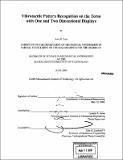Vibrotactile pattern recognition on the torso with one and two dimensional displays
Author(s)
Lam, Amy R. (Amy Rebecca)
DownloadFull printable version (1.454Mb)
Other Contributors
Massachusetts Institute of Technology. Dept. of Mechanical Engineering.
Advisor
Lynette A. Jones.
Terms of use
Metadata
Show full item recordAbstract
This research focused on the evaluation of a tactile display that is used for navigation and communication. In the first experiment, a four by four array of vibrating motors (tactors) was mounted on the torso while the subject wore an Interceptor Body Armor (IBA) vest. Subjects were required to identify which of eight patterns was presented. The results indicated that subjects could recognize the patterns presented with perfect accuracy, which indicates that wearing heavy body armor over the display does not affect the ability to perceive tactile inputs. A second set of experiments involved a one-dimension tactile array of eight tactors worn around the waist. The results indicated that the subjects could recognize the six circumferential patterns presented with an accuracy of 98-100% correct. A further experiment confirmed that the linear tactile display could be used to provide cues about the location of an event in the environment. These experiments showed that identification of the vibrotactile patterns was slightly superior on the two-dimension tactile array on the torso as compared to the one-dimension tactile array around the waist. (cont.) When subjects were required to identify the location of an individual vibrating motor using the one-dimensional array they achieved an accuracy of 94-100% correct. This suggests that a linear tactile array can be used to present navigational cues.
Description
Thesis (S.B.)--Massachusetts Institute of Technology, Dept. of Mechanical Engineering, 2006. Includes bibliographical references (leaves 27-28).
Date issued
2006Department
Massachusetts Institute of Technology. Department of Mechanical EngineeringPublisher
Massachusetts Institute of Technology
Keywords
Mechanical Engineering.